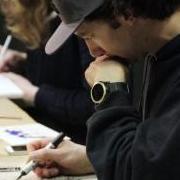Search the Community
Showing results for tags 'transformation'.
-
In short, how can I calculate the transformation matrix, or just rotation similar to how a geometry constraint/rivet works, where you define a few points as reference to glue a geo to an animated one? Long one: I want to procedurally animate the preroll of some packed RBDs, by comparing frame 1 and 2 of the simulation and project the objects backwards in time using that offset. It's a pre-broken sphere, so for translation, I find the average position of all points for both frames to calculate the offset per frame, which works great. [@P -= offset * backwardFrame;] The rotation part isn't as accurate though. I believe multiplying a rotation matrix with a scalar [@P*= rotMatrix*time] doesn't produce the desired results, so I am trying to calculate an axis and a rotation value that describes the difference between these two frames. I am currently picking the positions of 1 random but similar point in both geometries relative to their center, which I cross to find the axis. Then I use an acos(dot()) to get the angle between these two vectors. It almost works, but not 100% and picking a different point changes the result a bit. I guess that's happening because I need to take in consideration more than 1 points into the two geometry. thank you
-
Lets say you use c4d and you instance an object into different particles (with random rotations for example). If then you export that instanced geometry as an alembic and import it in 3ds max you get geometry with world transformation information (each geometry instanced has its own rotate/scale/translate info). Is it possible to do the same in Houdini?
-
- transformation
- particles
-
(and 3 more)
Tagged with:
-
Hey guys, how can I do something like this but within a pop network? Thx
- 7 replies
-
- particle
- transformation
-
(and 1 more)
Tagged with:
-
Hey folks, would there be a way to identify and extract, procedurally, animated rigid pieces from soft point deforming pieces? Say, you have a character alembic cache and several meshes on that character are rigid (i.e. their points don't change positions relative to each other). For example: the weapon of a warrior, or the plate armour, the shield... etc. I want to find those meshes procedurally and extract their transformations (and of course replace their point deformations with object-level transformations, duh...) Would you have a clue how to approach that? There wouldn't be a node for it already, would it? I'm thinking what heuristic to employ to differentiate between pieces which points do change positions relative to each other vs such that don't. Maybe just maybe... extract transformation matrices for every piece for some arbitrary prim, be it rigid or not multiply by the inverse to set each piece to the origin and... compute velocity in the result? all inversely tranformed points of rigid pieces have 0 velocity, some points (other than the points on the arbitrary prim from #1) of soft deforming pieces have v>0. tag them.
- 2 replies
-
- point-deform
- alembic
-
(and 2 more)
Tagged with:
-
Hello! I have this two models, one of them is an animated mixamo fbx of a character doing a spin-attack with a sword, and the other is a katana, the mixamo model doesn't have the sword, just the hand open like holding something. I isolated some points on the hand, got the centroid and created a point there, subtracted the position of two points in the palm and the transfered that vector as a normal to the central points where the sword will be, so its aligned to the hand, kind of. This worked for the first frame of the animation but get it comes to the spin the sowrd just keeps the same angle as in the first frame, the long of the sword is correctly oriented but the blade-side of the sword doesn't follow correctly the orientation of the hand. I'm still learning houdini and I for sure missing something and I don't know how to really look up for this anywhere else. Thanks. Here are some snaps: https://gyazo.com/f6dac5288ed223ac63a6ccea8b69fce5 https://gyazo.com/018df6bf2b990d3a9cd2cb8f2b0aff6b https://gyazo.com/0e6803c89574a2899cc7c4ecf005e8fa https://gyazo.com/1f886158016b065d9fca1400ffa4e380
- 2 replies
-
- fbx
- orientation
-
(and 5 more)
Tagged with:



